Origin and Early Evolution of Hydrocharitaceae and the Ancestral Role of Stratiotes
Abstract
:1. Introduction
2. Results
2.1. Systematic Description
2.2. Phylogeny of Hydrocharitaceae
2.3. Dated Phylogeny
2.4. Biogeographic Analysis
2.5. Climate Preferences Hydrocharitaceae
3. Discussion
3.1. The Paleophytogeographic History of Stratiotes
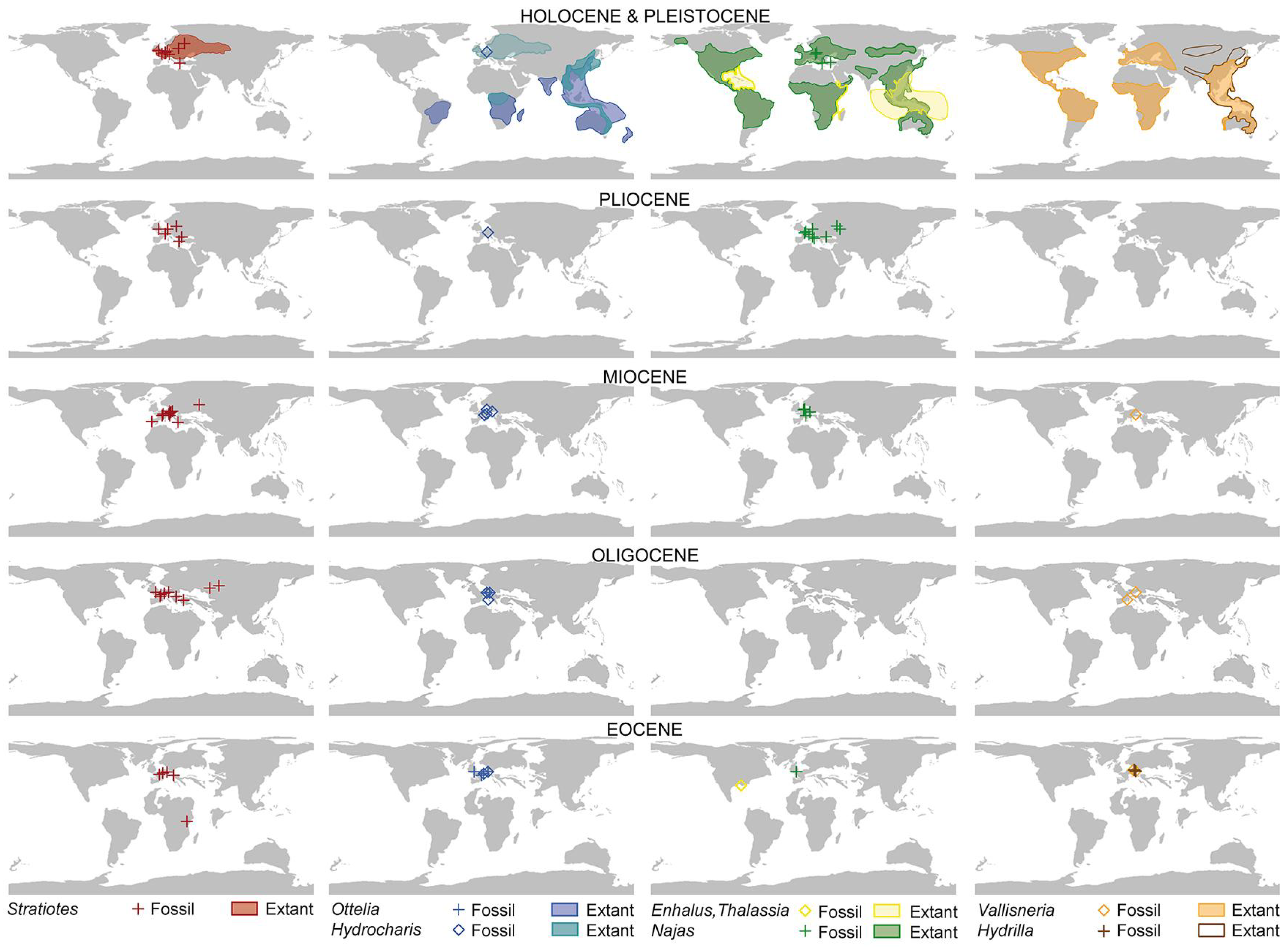
3.2. Ecological and Climatic Preferences of Extant and Fossil Stratiotes
3.3. Paleogene Origin and Dispersal of Hydrocharitaceae
4. Material and Methods
4.1. Origin of Samples
4.1.1. Messel, Germany, Europe
4.1.2. Dodori, Kenya, Africa
4.2. Preparation and Study of Samples
4.3. Geographic and Geological Background
4.3.1. Messel, Germany, Europe
4.3.2. Dodori, Kenya, Africa
4.4. Dated Phylogeny
4.5. Biogeographical Analysis
4.6. Climate Data Harvesting and Analysis
5. Conclusions and Future Considerations
Supplementary Materials
Author Contributions
Funding
Data Availability Statement
Acknowledgments
Conflicts of Interest
References
- Taylor, T.N.; Taylor, E.L.; Krings, M. Paleobotany—The Biology and Evolution of Fossil Plants; Academic Press: Cambridge, MA, USA, 2009. [Google Scholar]
- Friis, E.M.; Crane, P.R.; Pedersen, K.R. Early Flowers and Angiosperm Evolution; Cambridge University Press: Cambridge, UK, 2011. [Google Scholar]
- APG. An update of the Angiosperm Phylogeny Group classification for the orders and families of flowering plants: APG II. Bot. J. Linnéan Soc. 2003, 141, 399–436. [Google Scholar] [CrossRef]
- APG. An update of the Angiosperm Phylogeny Group classification for the orders and families of flowering plants: APG III. Bot. J. Linnéan Soc. 2009, 161, 105–121. [Google Scholar] [CrossRef]
- APG. An update of the Angiosperm Phylogeny Group classification for the orders and families of flowering plants: APG IV. Bot. J. Linnéan Soc. 2016, 181, 1–20. [Google Scholar] [CrossRef]
- Stevens, P. Angiosperm Phylogeny Website, Version 14. 2017. Available online: http://www.mobot.org/MOBOT/research/APweb/ (accessed on 15 December 2023).
- Tanaka, N.; Setoguchi, H.; Murata, J. Phylogeny of the Family Hydrocharitaceae Inferred from rbcL and matK Gene Sequence Data. J. Plant Res. 1997, 110, 329–337. [Google Scholar] [CrossRef]
- Les, D.H.; Moody, M.L.; Soros, C.L. A reappraisal of phylogentic relationships in the monocotyledon family Hydrocharitaceae (Alismatidae). Aliso J. Syst. Florist. Bot. 2006, 22, 211–230. [Google Scholar] [CrossRef]
- Chen, L.-Y.; Chen, J.-M.; Gituru, R.W.; Wang, Q.-F. Generic phylogeny, historical biogeography and character evolution of the cosmopolitan aquatic plant family Hydrocharitaceae. BMC Evol. Biol. Biol. 2012, 12, 30. [Google Scholar] [CrossRef] [PubMed]
- Bernardini, B.; Lucchese, F. New phylogenetic insights into Hydrocharitaceae. Ann. Bot. 2018, 8, 45–58. [Google Scholar] [CrossRef]
- Cook, C.D.K.; Urmi-König, K. A revision of the genus Stratiotes (Hydrocharitaceae). Aquat. Bot. 1983, 16, 213–249. [Google Scholar] [CrossRef]
- Cook, C. Hydrocharitaceae. In The Families and Genera of Vascular Plants. Volume 4. Flowering Plants. Monocotyledons. Alismatanae and Commelinanae (Except Gramineae); Kubitzki, K., Ed.; Springer: Berlin/Heidelberg, Germany, 1998; pp. 234–248. [Google Scholar]
- Katzenberger, J.; Zacharias, D. Mutualism of Stratiotes aloides L. (Hydrocharitaceae) and Hydrellia tarsata Haliday (Diptera: Ephydridae): Tritrophic interaction of macrophyte, leaf-mining dipteran pollinator and parasitoid Braconidae. J. Pollinat. Ecol. 2015, 15, 23–29. [Google Scholar] [CrossRef]
- Daumann, E. Zur Morphologie und Ökologie der Blüte von Stratiotes aloides L. Planta 1931, 14, 766–776. [Google Scholar] [CrossRef]
- Efremov, A.N.; Filonenko, A.V.; Sviridenko, B.F. Anatomy and morphology of reproductive organs of Stratiotes aloides L. (Hydrocharitaceae). Inland Water Biol. 2015, 8, 334–344. [Google Scholar] [CrossRef]
- Sun, K.; Chen, J.-K.; Zhang, Z.-Y. Pollen morphology of 15 species in nine genera of the Hydrocharitaceae. Acta Phytotaxon. Sin. 2002, 40, 490–500. [Google Scholar]
- Tanaka, N.; Uehara, K.; Murata, J. Correlation between pollen morphology and pollination mechanisms in the Hydrocharitaceae. J. Plant Res. 2004, 117, 265–276. [Google Scholar] [CrossRef] [PubMed]
- Toma, C. Reproduction of Stratiotes aloides in Ilmoilanselkä Lake (Finland). J. Ecol. Prot. Coastline 2012, 16, 103–111. [Google Scholar]
- Harms, F.-J.; Aderhold, G.; Hoffmann, I.; Nix, T.; Rosenberg, F. Erläuterungen zur Grube Messel bei Darmstadt (Südhessen). Schriftenreihe Dtsch. Geol. Ges. 1999, 8, 181–222. [Google Scholar]
- Felder, M.; Harms, F.J.; Wolf, K. Lithologie und genetische Interpretation der vulkano-sedimentären Ablagerungen aus der Grube Messel anhand der Forschungsbohrung Messel 2001 und weiterer Bohrungen. CFS Cour. Forschungsinstitut Senckenb. 2004, 252, 151–203. [Google Scholar]
- Vieira, M.; Bouchal, J.M.; Geier, C.; Ulrich, S.; Zetter, R.; Grímsson, F. Earliest fossil pollen records of endemic African Sclerosperma palms and the palaeoecological aspects of the genus. Rev. Palaeobot. Palynol. 2023, 317, 104954. [Google Scholar] [CrossRef]
- Wilde, V. Untersuchungen zur Systematik der Blattreste aus dem Mitteleozän der Grube Messel bei Darmstadt-(Hessen, Bundesrepublik Deutschland). CFS Cour. Forschungsinstitut Senckenb. 1989, 115, 1–213. [Google Scholar]
- Collinson, M.E.; Manchester, S.R.; Wilde, V. Fossil Fruits and Seeds of the Middle Eocene Messel biota, Germany. Abh. Senckenb. Ges. Naturforsch. 2012, 570, 1–251. [Google Scholar]
- Thiele-Pfeiffer, H. Die Mikroflora aus dem mitteleozänen Ölschiefer von Messel bei Darmstadt. Palaeontogr. Abt. B 1988, 211, 1–86. [Google Scholar]
- Bouchal, J.M.; Geier, C.; Ulrich, S.; Wilde, V.; Lenz, O.K.; Zetter, R.; Grímsson, F. Qualitative LM and SEM study of the Messel palynoflora: Part I. Algae to Vitales. Grana submitted. 2024.
- POWO. Plants of the World Online. Facilitated by the Royal Botanic Gardens, Kew. Available online: https://powo.science.kew.org/ (accessed on 1 February 2024).
- Cui, D.; Liang, S.; Wang, D.; Liu, Z. A 1 km global dataset of historical (1979–2013) and future (2020–2100) Köppen–Geiger climate classification and bioclimatic variables. Earth Syst. Sci. Data 2021, 13, 5087–5114. [Google Scholar] [CrossRef]
- Jacobs, B.F.; Pan, A.D.; Scotese, C.R.; Werdelin, L.; Sanders, W.J. A.D.; Scotese, C.R.; Werdelin, L.; Sanders, W.J. A review of the Cenozoic vegetation history of Africa. In Cenozoic Mammals of Africa; University of California Press: Berkeley, CA, USA, 2010; pp. 57–72. [Google Scholar]
- Turner, B.; Hameister, S.; Hudler, A.; Bernhardt, K. Genetic Diversity of Stratiotes aloides L. (Hydrocharitaceae) Stands across Europe. Plants 2021, 10, 863. [Google Scholar] [CrossRef]
- Zetter, R.; Hofmann, C.-C. New aspects of the palynoflora of the lowermost Eocene (Krappfeld area, Carinthia). Osterr. Akad. Wiss. Schiftenr. Erdwissenschaftlichen Komm. 2001, 14, 473–507. [Google Scholar]
- Ridley, H.N. The Dispersal of Plants throughout the World; L. Reeve & Co. Ltd.: Ashford, UK, 1930. [Google Scholar]
- Tang, C.Q.; Matsui, T.; Ohashi, H.; Dong, Y.-F.; Momohara, A.; Herrando-Moraira, S.; Qian, S.; Yang, Y.; Ohsawa, M.; Luu, H.T. Identifying long-term stable refugia for relict plant species in East Asia. Nat. Commun. 2018, 9, 4488. [Google Scholar] [CrossRef]
- Grímsson, F.; Graham, S.A.; Coiro, M.; Jacobs, B.F.; Xafis, A.; Neumann, F.H.; Scott, L.; Sakala, J.; Currano, E.D.; Zetter, R. Origin and divergence of Afro-Indian Picrodendraceae: Linking pollen morphology, dispersal modes, fossil records, molecular dating and paleogeography. Grana 2019, 58, 227–275. [Google Scholar] [CrossRef]
- Grímsson, F.; Kapli, P.; Hofmann, C.C.; Zetter, R.; Grimm, G.W. Eocene Loranthaceae pollen pushes back divergence ages for major splits in the family. PeerJ 2017, 5, e3373. [Google Scholar] [CrossRef]
- Grímsson, F.; Xafis, A.; Neumann, F.H.; Scott, L.; Bamford, M.K.; Zetter, R. The first Loranthaceae fossils from Africa. Grana 2018, 57, 249–259. [Google Scholar] [CrossRef] [PubMed]
- Couvreur, T.L.P.; Dauby, G.; Blach-Overgaard, A.; Deblauwe, V.; Dessein, S.; Droissart, V.; Hardy, O.J.; Harris, D.J.; Janssens, S.B.; Ley, A.C.; et al. Tectonics, climate and the diversification of the tropical African terrestrial flora and fauna. Biol. Rev. 2021, 96, 16–51. [Google Scholar] [CrossRef]
- Rage, J.-C.; Gheerbrant, E. Island Africa and vertebrate evolution: A review of data and working hypotheses. In Biological Consequences of Plate Tectonics: New Perspectives on Post-Gondwana Break-Up—A Tribute to Ashok Sahni; Springer International Publishing: Berlin/Heidelberg, Germany, 2020; pp. 251–264. [Google Scholar]
- Baas, J. Eine frühdiluviale Flora im Mainzer Becken. Z. Bot. 1932, 25, 289–371. [Google Scholar]
- Bennike, O.; Hoek, W. Late Glacial and early Holocene records of Stratiotes aloides L. from northwestern Europe. Rev. Palaeobot. Palynol. 1999, 107, 259–263. [Google Scholar] [CrossRef]
- Benzecry, A.; Brack-Hanes, S.D. A new hydrocharitacean seagrass from the Eocene of Florida. Bot. J. Linn. Soc. 2008, 157, 19–30. [Google Scholar] [CrossRef]
- Bogner, J.; Kvaček, Z. A fossil Vallisneria plant (Hydrocharitaceae) from the early Miocene freshwater deposits of the Most Basin (North Bohemia). Aquat. Bot. 2009, 90, 119–123. [Google Scholar] [CrossRef]
- Bohncke, S.J.P. Lateglacial environmental changes in the Netherlands: Spatial and temporal patterns: A contribution to the ‘North Atlantic seaboard programme’ of IGCP-253, ‘Termination of the Pleistocene’. Quat. Sci. Rev. 1993, 12, 707–717. [Google Scholar] [CrossRef]
- Bohncke, S.; Wijmstra, L.; Van Der Woude, J.; Sohl, H. The Late-Glacial infill of three lake successions in The Netherlands: Regional vegetational history in relation to NW European vegetational developments. Boreas 1988, 17, 385–402. [Google Scholar] [CrossRef]
- Bohncke, S.; Vandenberghe, J.; Huijzer, A.S. Periglacial environments during the Weichselian Late Glacial in the Maas valley, the Netherlands. Geol. Mijnb. 1993, 72, 193–210. [Google Scholar]
- Bohncke, S.; Kasse, C.; Vandenberghe, J. Climate induced environmental changes during the Vistulian Lateglacial at Zabinko, Poland. Quaest. Geogr. 1995, 4, 43–64. [Google Scholar]
- Bone, D.A. The stratigraphy of the Reading beds (Palaeocene), at Felpham, West Sussex. Tert. Res. 1986, 8, 17–32. [Google Scholar]
- Brack-Hanes, S.D.; Greco, A.M. Biomineralization in Thalassia testudinum (Liliopsida: Hydrocharitaceae) and an Eocene seagrass. Trans. Am. Microsc. Soc. 1988, 107, 286–292. [Google Scholar] [CrossRef]
- Bůžek, Č. Přispěvek k poznáni flóry panonu v Poštorné u Břeclavi. Čas. Miner. Geol. 1962, 7, 257–259. [Google Scholar]
- Cantemir, V.V.; Negru, A.G. Novye pozdnemiotsenovye vidy rastenij roda Najas L. Bul. Acad. Ştiinţe R.S.S. Mold. 1989, 2, 8–11. [Google Scholar]
- Chandler, M.E.J. The geological history of the genus Stratiotes: An account of the evolutionary changes which have occurred within the genus during Tertiary and Quaternary times. Q. J. Geol. Soc. 1923, 79, 117–138. [Google Scholar] [CrossRef]
- Chandler, M.E.J. The Upper Eocene Flora of Hordle, Hants. Part I. Monogr. Palaeontogr. Soc. 1925, 77, 1–32. [Google Scholar] [CrossRef]
- Chandler, M.E.J. Plant remains of the Hengistbury and Barton Beds. Bull. Br. Mus. Nat. Hist. Geol. 1960, 4, 193–238. [Google Scholar] [CrossRef]
- Chandler, M.E.J. The Lower Tertiary Floras of Southern England. III. Flora of the Bournemouth Beds; the Boscombe, and the Highcliff Sands; British Museum (Natural History): London, UK, 1963. [Google Scholar]
- Chandler, M.E.J. The Lower Tertiary Floras of Southern England. IV. A Summary and Survey of Findings in the Light of Recent Botanical Observations; British Museum (Natural History): London, UK, 1964. [Google Scholar]
- Cleveringa, P.; De-Gans, W.; Kolstrup, E.; Paris, F.P. Vegetational and climatic developments during the Late Glacial and the early Holocene and aeolian sedimentation as recorded in the Uteringsvee (Drente, The Netherlands). Geol. Mijnb. 1977, 56, 234–242. [Google Scholar]
- Collinson, M.E.; Cleal, C.J. The palaeobotany of the Palaeocene and Palaeocene-Eocene transitional strata in Great Britain. Geol. Conserv. Rev. Ser. 2001, 22, 155–184. [Google Scholar]
- Collinson, M.E. Fruit and seed floras from the Palaeocene/Eocene transition and subsequent Eocene in southern England: Comparison and palaeoenvironmental implications. GFF 2000, 122, 36–37. [Google Scholar] [CrossRef]
- Collinson, M.E.; Fowler, K.; Boulter, M.C. Floristic changes indicate a cooling climate in the Eocene of southern England. Nature 1981, 291, 315–317. [Google Scholar] [CrossRef]
- Collinson, M.E.; Hooker, J.J.; Gröcke, D.R. Cobham lignite bed and penecontemporaneous macrofloras of southern England: A record of vegetation and fire across the Paleocene-Eocene Thermal Maximum. Geol. Soc. Am. Spec. Pap. 2003, 369, 333–350. [Google Scholar]
- Čtyroký, P.; Knobloch, E. Neue paläontologische Untersuchungen im Pannon des NO-Teils des Wiener Beckens. Časopis Morav. Muz. Brné Vĕdy Přírodni 1976, 61, 97–114. [Google Scholar]
- Daley, B.; Edwards, N. The Bembridge Limestone (Late Eocene), Isle of Wight, southern England: A stratigraphical revision. Tert. Res. 1990, 12, 51–64. [Google Scholar]
- Daley, B. The palaeoenvironment of the Bembridge Marls (Oligocene) of the Isle of Wight, Hampshire. Proc. Geol. Assoc. 1973, 84, 83–93. [Google Scholar] [CrossRef]
- Denk, T.; Güner, T.H.; Kvaček, Z.; Bouchal, J.M. The early Miocene flora of Güvem (Central Anatolia, Turkey): A window into early Neogene vegetation and environments in the Eastern Mediterranean. Acta Palaeobot. 2017, 57, 237–338. [Google Scholar] [CrossRef]
- Dixon, F.S. Paleoecology of an Eocene Mud-Flat Deposit (Avon Park Formation, Claibornian) in Florida. Ph.D. Thesis, University of Florida, Gainesville, FL, USA, 1972. [Google Scholar]
- Dorofeev, P.I. On the systematics of the fossil Najads of the subgenus Caulinia (Willd.) Aschers. Bot. Zhurnal 1973, 58, 385–394. [Google Scholar]
- Dorofeev, P.I. Tretichnye Flory Zapadnoj Sibiri; Izdateľstvo Akademii Nauk SSSR: Moscow, Russia, 1963. [Google Scholar]
- Dorofeev, P.I. Novye Dannye o Pliotsenovoj Flore Bashkirii. In Stratigrafija Chetvertichnykh (Antropogenovykh) Otlozhenij Urala; Yakhimovich, V.L., Lider, V.A., Eds.; Izdatel’stvo “Nedra”: Moscow, Russia, 1965; pp. 191–219. [Google Scholar]
- Dorofeev, P.I. Pliotsenovaja Flora Matanova Sada Na Donu; Izdatel’stvo “Nauka”, Leningradskoe otdelenie: Leningrad, Russia, 1966. [Google Scholar]
- Edwards, N.; Daley, B. Stratigraphy of the Totland Bay Member (Headon Hill Formation, Late Eocene) at Hordle Cliff, Hampshire, southern England. Tert. Res. 1997, 18, 35–50. [Google Scholar]
- Friis, E.M. Angiosperm fruits and seeds from the Middle Miocene of Jutland (Denmark). K. Dan. Vidensk. Selsk. Biol. Skr. 1985, 24, 1–165. [Google Scholar]
- Gotjé, W. De Holocene Laagveenontwikkeling in de Randzone van de Nederlandse Kustvlakte (Noordoostpolder); Vrije Universiteit: Amsterdam, The Netherlands, 1993. [Google Scholar]
- Grambast, L. Flore de l’Oligocène supérieur du Bassin de Paris. Ann. Paléontologie 1962, 48, 85–126. [Google Scholar]
- Gregor, H.-J. Trapa zapfei Berger aus dem Untermiozän von Langau bei Geras (NÖ.)—Eine Hydrocharitacee. Ann. Naturhistorischen Mus. Wien 1980, 88, 105–118. [Google Scholar]
- Gregor, H.J. Contributions to the late Neogene and early Quaternary floral history of the Mediterranean. Rev. Palaeobot. Palynol. 1990, 62, 309–338. [Google Scholar] [CrossRef]
- Hantke, R. Die fossile Flora der obermiozänen Oehninger-Fundstelle Schrotzburg (Schienerberg, Süd-Baden). Denkschr. Schweiz. Naturforschenden Ges. 1954, 80, 27–118. [Google Scholar]
- Hartz, N. Bidrag til Danmarks tertiære og diluviale Flora. Dan. Geol. Undersøgelse II Række 1909, 20, 1–292. [Google Scholar]
- Hayes, P.A.; Collinson, M.E. The flora of the Insect Limestone (latest Eocene) from the Isle of Wight, southern England. Earth Environ. Sci. Trans. R. Soc. Edinb. 2014, 104, 245–261. [Google Scholar] [CrossRef]
- Heer, O. Die Tertiäre Flora Der Schweiz.—Flora Tertiara Helvetiae Vol 1; Verlag Wurster & Co.: Winterthur, Switzerland, 1855. [Google Scholar]
- Heer, O. Die Tertiäre Flora Der Schweiz.—Flora Tertiara Helvetiae Vol 2; Verlag Wurster & Co.: Winterthur, Switzerland, 1856. [Google Scholar]
- Henniger, M.; Leder, R.M.; Müller, A. Paläogene Fossilien aus einer Karstschlotte im Unteren Muschelkalk von Karsdorf an der Unstrut (Sachsen-Anhalt, Burgenlandkreis). Z. Dtsch. Ges. Geowiss. 2011, 162, 317–332. [Google Scholar]
- Holý, F.; Bůžek, C. Seeds Stratiotes L. (Hydrocharitaceae) in the Tertiary of Czechoslovakia. Sborník Geol. Věd Paleontol. 1966, 8, 105–135. [Google Scholar]
- Iles, W.J.D.; Smith, S.Y.; Gandolfo, M.A.; Graham, S.W. Monocot fossils suitable for molecular dating analyses. Bot. J. Linn. Soc. 2015, 178, 346–374. [Google Scholar] [CrossRef]
- Ivany, L.C.; Portell, R.W.; Jones, D.S. Animal-plant relationships and paleobiogeography of an Eocene seagrass community from Florida. Palaios 1990, 5, 244–258. [Google Scholar] [CrossRef]
- Jakubovskaja, T.V. Ranneantrapagenavyya Nasennyya Flory Belaruskaj Grady i Ikh Stratygrafichnae Stanovishcha. In Dasledavanni antrapagenu Belarusi; Kuzniatsow, U.A., Ed.; Navuka i Tekhnika: Minsk, Russia, 1978; pp. 93–105. [Google Scholar]
- Junge, F.W.; Dolezych, M.; Walther, H.; Böttger, T.; Kühl, A.; Kunzmann, L.; Morgenstein, P.; Steinberg, T.; Stange, R. Ein Fenster in Landschaft und Vegetation vor 37 Millionen Jahren: Lithologische, sedimentgeochemische und paläobotanische Befunde aus einem Paläoflusssystem des Weißelsterbeckens. Mauritiana 2005, 19, 185–273. [Google Scholar]
- Juzepczuk, S.V.S. Najadovye-Najadaceae Benth. et Hook. F. In Flora SSSR I; Komarov, V.L., Ed.; Izdateľstvo Akademii Nauk SSSR: Leningrad, Russia, 1934; pp. 269–275. [Google Scholar]
- Kirchheimer, F. Über die botanische Zugehörigkeit weiterer Früchte und Samen aus dem deutschen Tertiär. Planta 1936, 25, 481–490. [Google Scholar] [CrossRef]
- Kirchheimer, F. Die Laubgewächse der Braunkohlenzeit; Veb Wilhelm Knapp Verlag: Halle, Germany, 1957. [Google Scholar]
- Knobloch, E. Tertiäre Floren von Mähren; Moravské Museum: Brno, Czech Republic, 1969. [Google Scholar]
- Knobloch, E. Samen und Früchte aus dem Pannon von Kunovice (Mähren). Věstník Ústředního Ust. Geol. 1976, 51, 221–230. [Google Scholar]
- Knobloch, E. Die untermiozäne Flora von Šafov in Südmähren. Věstník Ústředního Ust. Geol. 1978, 53, 153–162. [Google Scholar]
- Knobloch, E. Neue paläontologische Untersuchungen im Pannon und Pont des mährischen Teils des Wiener Beckens. Sborník Národního Muz. Praze Řada B 1981, 37, 205–227. [Google Scholar]
- Knobloch, E. Svrchnomiocénní flóra z Bernartic u Javorníka na severní Moravĕ. Časopis Slez. Zemského Muz. Série A 1982, 31, 249–264. [Google Scholar]
- Knobloch, E. Biometrie und Morphologie der Samen von Stratiotes kaltennordheimensis und S. tuberculatus aus dem mitteleuropäischen Neogen. Sborník Geol. Věd Paleontol. 1989, 30, 159–173. [Google Scholar]
- Kräusel, R. Pflanzenreste aus den diluvialen Ablagerungen im Ruhr-Emscher-Lippe-Gebiete. Decheniana 1937, 95A, 207–240. [Google Scholar]
- Kvaček, Z.; Hurník, S. Revision of Early Miocene plants preserved in baked rocks in the North Bohemian Tertiary. Sborník Národního Muz. Praze. Řada B Přírodní Vědy 2000, 56, 1–48. [Google Scholar]
- Kvaček, Z. The Hydrocharitaceae foliage from the North Bohemian early miocene. Věstník Českého Geol. Ust. 1995, 70, 21–27. [Google Scholar]
- Kvaček, Z. Bílina: A window on Early Miocene marshland environments. Rev. Palaeobot. Palynol. 1998, 101, 111–123. [Google Scholar] [CrossRef]
- Kvaček, Z. Aquatic angiosperms of the early Miocene Most Formation of North Bohemia (Central Europe). Cour. Forschungsinstitut Senckenb. 2003, 241, 255–279. [Google Scholar]
- Kvaček, Z.; Böhme, M.; Dvořák, Z.; Konzalová, M.; Mach, K.; Prokop, J.; Rajchl, M. Early Miocene freshwater and swamp ecosystems of the Most Basin (northern Bohemia) with particular reference to the Bílina Mine section. J. Czech Geol. Soc. 2004, 49, 1–40. [Google Scholar]
- Laurent, L. Flora Des Calcaires de Célas; Moullot Fils: Marseille, France, 1899. [Google Scholar]
- Ludwig, R. Fossile Pflanzen aus der ältesten Abtheilung der Rheinisc–Wetterauer Tertiär-Formation. Palaeontographica 1859, 8, 39–72. [Google Scholar]
- Lumber, S.H.; den Hartog, C.; Phillips, R.C.; Olsen, F.S. The occurrence of fossil seagrasses in the Avon Park Formation (late middle Eocene), Levy County, Florida (USA). Aquat. Bot. 1984, 20, 121–129. [Google Scholar] [CrossRef]
- Mai, D.H.; Walther, H. Die Floren der Haselbacher Serie im Weßelster-Becken (Bezirk Leipzig, DDR). Abh. Staatl. Mus. Mineral. Geol. Dresd. 1978, 28, 1–200. [Google Scholar]
- Mai, D.H.; Walther, H. Die pliozänen Floren von Thürigen, Deutsche Demokratische Republic. Quartärpaläontologie 1988, 7, 55–297. [Google Scholar]
- Mai, D.H.; Walther, H. Die oligozänen und untermiozänen Floren Nordwest-Sachsens und des Bitterfelder Raumes. Abh. Staatl. Mus. Mineral. Geol. Dresd. 1991, 38, 1–230. [Google Scholar]
- Mai, D.H.; Walther, H. Die obereozänen Floren des Weißelster-Beckens und seiner Randgebiete. Abh. Staatl. Mus. Mineral. Geol. Dresd. 1985, 33, 1–260. [Google Scholar]
- Mai, D.H. Neue Arten nach Früchten und Samen aus dem Tertiär von Nordwestsachsen und der Lausitz. Feddes Repert. 1987, 98, 105–126. [Google Scholar] [CrossRef]
- Mai, D.H. Tertiäre Vegetationsgeschichte Europas; Gustav Fischer Verlag: Stuttgart, Germany, 1995. [Google Scholar]
- Mai, D.H. Die oberoligozänen Floren am Nordrand der Sächsischen Lausitz. Palaeontogr. Abt. B 1997, 244, 1–124. [Google Scholar]
- Mai, D.H. Die untermiozänen Floren aus der Spremberger Folge und dem 2. Flözhorizont in der Lausitz Teil I: Farnpflanzen, Koniferen und Monokotyledonen. Palaeontogr. Abt. B 1999, 250, 1–76. [Google Scholar] [CrossRef]
- Mai, D.H. Die mittelmiozänen und obermiozänen Floren aus der Meuroer und Raunoer Folge in der Lausitz Teil I: Farnpflanzen, Koniferen und Monokotyledonen. Palaeontogr. Abt. B 2000, 256, 1–68. [Google Scholar] [CrossRef]
- Massalongo, A.B. Plantae Fossiles Novae in Formationibus Tertiariis Regni Veneti Nuper Inventae; Ramanzini: Verona, Italy, 1853. [Google Scholar]
- Meller, B. Systematisch-taxonomische Untersuchungen von Karpo-Taphocoenosen des Köflach-Voitsberger Braunkohlenrevieres (Steiermark, Österreich; Untermiozän) und ihre paläoökologische Bedeutung. Jahrb. Geol. Bundesanst. 1998, 140, 497–655. [Google Scholar]
- Miller, J.A. Hydrogeologic Framework of the Floridan Aquifer System in Florida and Parts of Georgia, Alabama, and South Carolina; Department of the Interior, US Geological Survey: Washington, DC, USA, 1986; Volume 1403. [Google Scholar]
- Nikitin, P.A. Akvitanskaja Semennaja Flora Lagernogo Sada (Tomsk); Izdatel’stvo Tomskogo Universiteta: Tomsk, Russia, 1965. [Google Scholar]
- Nikitin, V.P. Paleokarpologija i Stratigrafija Paleogena i Neogena Aziatskoj Rossii; Akademicheskoe izdatel’stvo “Geo”: Novosibirsk, Russia, 2007. [Google Scholar]
- Pais, J. Contribuição Para o Conhecimento da Vegetação Miocénica da Parte Ocidental da Bacia do Tejo; Universidade Nova de Lisboa: Lisbon, Portugal, 1981. [Google Scholar]
- Palamarev, E. Fossile Floren aus drei Braunkohlebecken in Südwestbulgarien. Izv. Bot. Inst. 1970, 20, 35–79. [Google Scholar]
- Palamarev, E. Fosilnata flora na vuglenosniya eotsen v Burgasko. Izv. Bot. Inst. 1973, 24, 75–124. [Google Scholar]
- Palamarev, E. Die Gattung Stratiotes L. in der Tertiärflora Bulgariens und ihre Entwicklungsgeschichte in Eurasien. Phytology 1979, 12, 3–36. [Google Scholar]
- Palamarev, E. Paläokarpologische Untersuchungen des Braunkohlenjungtertiärs in Bulgarien. Palaeontogr. Abt. B Paläophytologie 1994, 232, 129–154. [Google Scholar]
- Palamarev, E.; Ivanov, D.; Kitanov, G. New data about the fossil flora from Bobovdol basin and its biostratigraphic significance. Spis. Bălgarskoto Geol. 1998, 59, 13–21. [Google Scholar]
- Palamarev, E.H.; Bozukov, V.; Uzunova, K.; Petkova, A.; Kitanov, G. Catalogue of the Cenozoic plants of Bulgaria (Eocene to Pliocene). Phytol. Balc. 2005, 11, 215–364. [Google Scholar]
- Paris, F.P.; Cleveringa, P.; de Gans, W. The Stokersdobbe: Geology and palynology of a deep pingo remnant in Friesland (The Netherlands). Geol. Mijnb. 1979, 58, 33–38. [Google Scholar]
- Rasmussen, E.S.; Dybkjær, K.; Piasecki, S. Lithostratigraphy of the upper Oligocene–Miocene succession of Denmark. Geol. Surv. Den. Greenl. Bull. 2010, 22, 1–92. [Google Scholar]
- Reid, E.M.; Chandler, M.E.J. Catalogue of Cainozoic Plants in the Department of Geology. Volume 1. The Bembridge Flora; British Museum (Natural History): London, UK, 1926. [Google Scholar]
- Reid, C.; Reid, E.M. Fossil flora of Tegelen-sur-Meuse, near Venloo, in the Province of Limburg. Verh. K. Akad. Wet. Amst. 1907, Deel XIII. N° 6, 1–26. [Google Scholar]
- Reid, C.; Reid, E.M. The Pliocene floras of the Dutch-Prussian border. Meded. Rijksopspor. Delftstoffen 1915, 6, 1–178. [Google Scholar]
- Reid, E.M. Recherches sur quelques graines pliocènes du Pont-du-Gail (Cantal). Bull. Société Géologique Fr. 1920, 20, 48–87. [Google Scholar]
- Riškienė, M.A. Novyj vid roda Najas v mezhlednikovykh otlozhenijakh obnazhenija v Bujvidzhjaj. Liet. Geol. Moksl. Tyrim. Institutas Darb. 1974, 27, 119–122. [Google Scholar]
- Saporta, G. Études sur la végétation du niveau du Sud-Est de la France à l’époque tertiaire. Ann. Sci. Nat. Bot. Ser. V 1873, 17, 5–44. [Google Scholar]
- De Saporta, G. Le Monde des Plantes Avant l’apparition de l’homme; G. Masson: Paris, France, 1879. [Google Scholar]
- Schaarschmidt, F. Präparation und Untersuchung der eozänen Pflanzenfossilien von Messel bei Darmstadt. Cour. Forschungsinstitut Senckenb. 1982, 56, 59–77. [Google Scholar]
- Schimper, W.P. Traité de Paléontologie Végétale, Ou: Flore du Monde Primitif Dans Ses Rapports Avec les Formations Géologique et la Flore du Monde Actuel; Baillière: Paris, France, 1869; Volume 1. [Google Scholar]
- Sille, N.P.; Collinson, M.E.; Kucera, M.; Hooker, J.J. Evolution within the charophyte genus Harrisichara, late Paleogene, southern England; environmental and biostratigraphic implications. Palaeogeogr. Palaeoclimatol. Palaeoecol. 2004, 208, 153–173. [Google Scholar] [CrossRef]
- Sille, N.P.; Collinson, M.E.; Kucera, M.; Hooker, J.J. Morphological evolution of Stratiotes through the Paleogene in England: An example of microevolution in flowering plants. Palaios 2006, 21, 272–288. [Google Scholar] [CrossRef]
- Straus, A. Die oberpliozäne Flora von Willershausen am Harz. Berichte Naturhistorischen Ges. Hann. 1992, 134, 7–115. [Google Scholar]
- Stuchlik, L.; Szynkiewicz, A.; Łańcuka-Środoniowa, M.; Zastawniak, E. Results of the hitherto palaeobotanical investigations of the Tertiary brown coal bed “Bełchatów” (Central Poland). Acta Palaeobot. 1990, 30, 259–305. [Google Scholar]
- Sukaczev, V.N. O vidakh roda Najas iz otlozhenij Likhvinskogo mezhlednikov’ja. Bot. Zhurnal 1958, 43, 239–242. [Google Scholar]
- Ţicleanu, N. Macroflore et Végétation Daciènnes Du Bassin Dacique. In Chronostratigraphie und Neostratotypen. Neogen der Zentrale Paratethys. Bd 9; Marinescu, F.L., Papaianopol, I., Eds.; Rumänische Akademie: Bucharest, Romania, 1995; Volume 11, pp. 473–497. [Google Scholar]
- Tobolski, K. Holocene vegetational development based on the Kluki reference site in the Gardno-Łeba Plain. Acta Palaeobot. 1987, 27, 179–222. [Google Scholar]
- Tolonen, K. The history of the Stratiotes lakes of northern Fennoscandia in the light of stratigraphical studies. Wahlenbergia 1981, 7, 167–177. [Google Scholar]
- Uhl, D. Neue Funde der fossilen Krebsschere Stratiotes kaltennordheimensis (Zenker) Keilhack (Hydrocharitaceae) aus dem Oberoligozän des Westerwaldes (Rheinland-Pfalz, W-Deutschland). Mitt. Pollichia 2017, 98, 41–50. [Google Scholar]
- Uhl, D.; Bruch, A.A.; Traiser, C.; Klotz, S. Palaeoclimate estimates for the Middle Miocene Schrotzburg flora (S Germany): A multi-method approach. Int. J. Earth Sci. 2006, 95, 1071–1085. [Google Scholar] [CrossRef]
- Velitzelos, D.; Bouchal, J.M.; Denk, T. Review of the Cenozoic Floras and Vegetation of Greece. Rev. Palaeobot. Palynol. 2014, 204, 56–117. [Google Scholar] [CrossRef]
- Vernon, R.O. Geology of citrus and levy counties, Florida. Fla. Geol. Surv. Bull. 1951, 33, 95–111. [Google Scholar]
- Wessel, P.; Weber, C.O. Neuer Beitrag zur Tertiärflora der niederrheinischen Braunkohlenformation. Palaeontographica 1855, 4, 111–168. [Google Scholar]
- Weyland, H. Beiträge zur Kenntnis der Rheinischen Tertiärflora: VI. Vierte Ergänzungen und Berichtigungen zur Flora der Blätterkohle und des Polierschiefers von Rott im Siebengebirge. Palaeontogr. Abt. B 1943, 87, 94–136. [Google Scholar]
- Wieliczkiewicz, F. Antropogenovye Semennye Flory Belorussii i Smezhnykh Oblastej; Nauka i Tekhnika: Minsk, Russia, 1973. [Google Scholar]
- Wieliczkiewicz, F. Istorija Plejstotsenovoj Flory Srednej Polosy Vostochno-Evropejskoj Ravniny. In Sovetskaja Paleokarpologija; Goretzky, G.I., Grichuk, V.P., Eds.; Izdatel’stvo “Nauka”: Moscow, Russia, 1979; pp. 76–121. [Google Scholar]
- Wieliczkiewicz, F. Plejstotsenovye Flory Lednikovykh Oblastej Vostochno-Evropejskoj Ravniny; Nauka i Tekhnika: Minsk, Russia, 1982. [Google Scholar]
- Witte, H. Stratiotes aloides L. funnen i Sveriges postglaciala aflagringar. Geol. Föreningen I Stock. Förhandlingar 1905, 27, 432–451. [Google Scholar] [CrossRef]
- Worobiec, G. New fossil floras from Neogene deposits in the Bełchatów Lignite Mine. Acta Palaeobot. Suppl. 2003, 3, 3–133. [Google Scholar]
- Zoller, H. Ein fossiles, wärmzeitliches Vorkommen von Stratiotes aloides L. in der subalpinen Stufe des unteren Misox (Südschweitz). Veröffentlichungen Geobot. Inst. Rübel Zürich 1958, 33, 280–286. [Google Scholar]
- Lim, J.Y.; Huang, H.; Farnsworth, A.; Lunt, D.J.; Baker, W.J.; Morley, R.J.; Kissling, W.D.; Hoorn, C. The Cenozoic history of palms: Global diversification, biogeography and the decline of megathermal forests. Glob. Ecol. Biogeogr. 2022, 31, 425–439. [Google Scholar] [CrossRef]
- Blakey, R.C.; Fielding, C.R.; Frank, T.D.; Isbell, J.L. Gondwana paleogeography from assembly to breakup—A 500 my odyssey. Geol. Soc. Am. Spec. Pap. 2008, 441, 1–28. [Google Scholar]
- Blakey, R.C. Paleogeography of Europe [CD with Geographic Maps and PowerPoint Presentations]; Colorado Plateau Geosystems, Inc.: Phoenix, AZ, USA, 2011. [Google Scholar]
- Rasser, M.W.; Harzhauser, M.; Anistratenko, O.Y.; Anistrenki, V.V.; Bassi, D.; Belak, M.; Berger, J.P.; Bianchini, G.; Čičič, S.; Ćosović, V.; et al. Palaeogene and Neogene. In The Geology of Central Europe Volume 2: Mesozoic and Cenozoic; McCann, T., Ed.; The Geological Society: London, UK, 2008; pp. 1031–1140. [Google Scholar]
- Mai, D.H. Entwicklung der Wasser-und Sumpfpflanzen Gesellschaften Europas von der Kreide bis ins Quartär. Flora 1985, 176, 449–511. [Google Scholar] [CrossRef]
- Büchel, G.N.; Schaal, S.F.K. Chapter 2. The Formation of the Messel Maar. In Messel. An Ancient Greenhouse Ecosystem; Smith, K.T., Schaal, S.F.K., Habersetzer, J., Eds.; Senkenberg: Frankfurt, Germany, 2018; pp. 7–15. [Google Scholar]
- Lenz, O.K.; Wilde, V.; Moshayedi, M.; Mutzl, J.; Hinderer, M. High-resolution regional vegetation analyses for Eocene records on the Sprendlinger Horst in Southwest Germany. Z. Dtsch. Ges. Geowiss. 2023, 174, 613–632. [Google Scholar] [CrossRef]
- Smith, K.T.; Lehmann, T.; Mayr, G.; Micklich, N.; Rabenstein, R.; Wedmann, S. Chapter 13. The Messel Ecosystem. In Messel. An Ancient Greenhouse Ecosystem; Smith, K.T., Schaal, S.F.K., Habersetzer, J., Eds.; Senckenberg: Frankfurt, Germany, 2018; pp. 303–313. [Google Scholar]
- Nyagah, K. Stratigraphy, depositional history and environments of deposition of Cretaceous through Tertiary strata in the Lamu Basin, southeast Kenya and implications for reservoirs for hydrocarbon exploration. Sediment. Geol. 1995, 96, 43–71. [Google Scholar] [CrossRef]
- Kottek, M.; Grieser, J.; Beck, C.; Rudolf, B.; Rubel, F. World map of the Köppen-Geiger climate classification updated. Meteorol. Z. 2006, 15, 259–263. [Google Scholar] [CrossRef] [PubMed]
- Zachos, J.C.; Pagani, M.; Sloan, L.; Thomas, E.; Billups, K. Trends, rhythms, and aberrations in global climate 65 Ma to present. Science 2001, 292, 686–693. [Google Scholar] [CrossRef] [PubMed]
- Mosbrugger, V.; Utescher, T.; Dilcher, D.L. Cenozoic continental climatic evolution of Central Europe. Proc. Natl. Acad. Sci. USA 2005, 102, 14964–14969. [Google Scholar] [CrossRef] [PubMed]
- Grein, M.; Utescher, T.; Wilde, V.; Roth-Nebelsick, A. Reconstruction of the middle Eocene climate of Messel using palaeobotanical data. Neues Jahrb. Geol. Palaontol.-Abh. 2011, 260, 305–318. [Google Scholar] [CrossRef]
- Tütken, T. Isotope compositions (C, O, Sr, Nd) of vertebrate fossils from the Middle Eocene oil shale of Messel, Germany: Implications for their taphonomy and palaeoenvironment. Palaeogeogr. Palaeoclimatol. Palaeoecol. 2014, 416, 92–109. [Google Scholar] [CrossRef]
- Evans, D.; Sagoo, N.; Renema, W.; Cotton, L.J.; Müller, W.; Todd, J.A.; Saraswati, P.K.; Stassen, P.; Ziegler, M.; Pearson, P.N.; et al. Eocene greenhouse climate revealed by coupled clumped isotope-Mg/Ca thermometry. Proc. Natl. Acad. Sci. USA 2018, 115, 1174–1179. [Google Scholar] [CrossRef] [PubMed]
- Sagoo, N.; Valdes, P.; Flecker, R.; Gregoire, L.J. The early Eocene equable climate problem: Can perturbations of climate model parameters identify possible solutions? Philos. Trans. R. Soc. Math. Phys. Eng. Sci. 2013, 371, 20130123. [Google Scholar] [CrossRef] [PubMed]
- Lenz, O.K.; Wilde, V.; Riegel, W. Recolonization of a Middle Eocene volcanic site: Quantitative palynology of the initial phase of the maar lake of Messel (Germany). Rev. Palaeobot. Palynol. 2007, 145, 217–242. [Google Scholar] [CrossRef]
- Grímsson, F.; Denk, T.; Zetter, R. Pollen, fruits, and leaves of Tetracentron (Trochodendraceae) from the Cainozoic of Iceland and western North America and their palaeobiogeographic implications. Grana 2008, 47, 1–14. [Google Scholar] [CrossRef]
- Stratiotes aloides, L. Available online: https://wu.jacq.org/WU0152794 (accessed on 15 December 2023).
- Zetter, R. Methodik und Bedeutung einer routinemäßig kombinierten lichtmikroskopischen und rasterelektronenmikroskopischen Untersuchung fossiler Mikrofloren. Cour. Forschungsinstitut Senckenb. 1989, 109, 41–50. [Google Scholar]
- Halbritter, H.; Ulrich, S.; Grímsson, F.; Weber, M.; Zetter, R.; Hesse, M.; Buchner, R.; Svojtka, M.; Frosch-Radivo, A. Illustrated Pollen Terminology, 2nd ed.; Springer Nature: Cham, Switzerland, 2018. [Google Scholar]
- Ulrich, S.; Grímsson, F. The single-grain method: Adding TEM to the equation. Grana 2020, 59, 44–57. [Google Scholar] [CrossRef] [PubMed]
- Punt, W.; Hoen, P.P.; Blackmore, S.; Nilsson, R.H.; Thomas, A. Le Glossary of pollen and spore terminology. Rev. Palaeobot. Palynol. 2007, 143, 1–81. [Google Scholar] [CrossRef]
- Ludwig, R. Fossile Crocodiliden Aus der Tertiärformation des Mainzer Beckens; Fischer: Stuttgart, Germany, 1877; Volume 3. [Google Scholar]
- Schaal, S.; Ziegler, W. Messel—Ein Schaufenster in der Geschichte der Erde und des Lebens; Verlag Waldemar Kramer: Frankfurt am Main, Germany, 1988. [Google Scholar]
- Gruber, G.; Micklich, N. (Eds.) Messel Treasures of the Eocene; Hessisches Landesmuseum Darmstadt: Darmstadt, Germany, 2007. [Google Scholar]
- Smith, K.; Schaal, S.; Habersetzer, J. (Eds.) Messel—An Ancient Greenhouse Ecosystem; Senckenberg Gesellschaft für Naturforschung: Frankfurt am Main, Germany, 2018. [Google Scholar]
- Mertz, D.F.; Renne, P.R. A numerical age of for the Messel fossil deposit (UNESCO World Heritage Site) derived from 40Ar/39Ar dating on a basaltic rock fragment. Cour. Forsch.-Inst. Senckenb. 2005, 255, 67–75. [Google Scholar]
- Lenz, O.K.; Wilde, V.; Mertz, D.F.; Riegel, W. New palynology-based astronomical and revised 40Ar/39Ar ages for the Eocene maar lake of Messel (Germany). Int. J. Earth Sci. 2015, 104, 873–889. [Google Scholar] [CrossRef]
- Kaboth-Bahr, S.; Schmitt, C.; Bauersachs, T.; Zeeden, C.; Wonik, T.; Schandl, J.; Lenz, O.; Wedmann, S.; Vasiliev, I.; Mulch, A. Improved chronostratigraphy for the Messel Formation (Hesse, Germany) provides insight into early to middle Eocene climate variability. Newsl. Stratigr. 2024. [Google Scholar] [CrossRef]
- Nyaberi, M.D.; Rop, B.K. Petroleum prospects of Lamu Basin, South-Eastern Kenya. J. Geol. Soc. India 2014, 83, 414–422. [Google Scholar] [CrossRef]
- ICS. International Chronostratigraphic Chart V2023/09. Available online: https://stratigraphy.org/ICSchart/ChronostratChart2023-09.pdf (accessed on 10 January 2024).
- Ronquist, F.; Klopfstein, S.; Vilhelmsen, L.; Schulmeister, S.; Murray, D.L.; Rasnitsyn, A.P. A total-evidence approach to dating with fossils, applied to the early radiation of the hymenoptera. Syst. Biol. 2012, 61, 973–999. [Google Scholar] [CrossRef] [PubMed]
- Miller, M.A.; Pfeiffer, W.; Schwartz, T. Creating the CIPRES Science Gateway for Inference of Large Phylogenetic Trees. In Proceedings of the 2010 Gateway Computing Environments Workshop (GCE), IEEE, New Orleans, LA, USA, 14 November 2010; pp. 1–8. [Google Scholar] [CrossRef]
- Barido-Sottani, J.; Aguirre-Fernández, G.; Hopkins, M.J.; Stadler, T.; Warnock, R. Ignoring stratigraphic age uncertainty leads to erroneous estimates of species divergence times under the fossilized birth-death process. Proc. R. Soc. B Biol. Sci. 2019, 286, 20190685. [Google Scholar] [CrossRef] [PubMed]
- Rambaut, A.; Drummond, A.J.; Xie, D.; Baele, G.; Suchard, M.A. Posterior summarisation in Bayesian phylogenetics using Tracer 1.7. Syst. Biol. 2018; 67, 901–904. [Google Scholar] [CrossRef]
- Matzke, N. BioGeoBEARS: Biogeography with Bayesian (and Likelihood) Evolutionary Analysis with R Scripts. v.1.1.1 2018. Available online: https://github.com/nmatzke/BioGeoBEARS/releases/tag/v1.1.1 (accessed on 20 January 2024).
- Denk, T.; Grimm, G.W.; Grímsson, F.; Zetter, R. Evidence from “Köppen signatures” of fossil plant assemblages for effective heat transport of Gulf Stream to subarctic North Atlantic during Miocene cooling. Biogeosciences 2013, 10, 7927–7942. [Google Scholar] [CrossRef]
- Vieira, M.; Zetter, R.; Grímsson, F.; Denk, T. Niche evolution versus niche conservatism and habitat loss determine persistence and extirpation in late Neogene European Fagaceae. Quat. Sci. Rev. 2023, 300, 107896. [Google Scholar] [CrossRef]
- Grímsson, F.; Grimm, G.W.; Meller, B.; Bouchal, J.M.; Zetter, R. Combined LM and SEM study of the middle Miocene (Sarmatian) palynoflora from the Lavanttal Basin, Austria: Part IV. Magnoliophyta 2—Fagales to Rosales. Grana 2016, 55, 101–163. [Google Scholar] [CrossRef]
- Bouchal, J.M.; Güner, T.H.; Velitzelos, D.; Velitzelos, E.; Denk, T. Messinian vegetation and climate of the intermontane Florina–Ptolemais–Servia Basin, NW Greece inferred from palaeobotanical data: How well do plant fossils reflect past environments? R. Soc. Open Sci. 2020, 7, 192067. [Google Scholar] [CrossRef] [PubMed]
- Geier, C.; Bouchal, J.M.; Ulrich, S.; Gross, M.; Zetter, R.; Denk, T.; Grímsson, F. Paleovegetation and paleoclimate inferences of the early late Sarmatian palynoflora from the Gleisdorf Fm. at Gratkorn, Styria, Austria. Rev. Palaeobot. Palynol. 2022, 307, 104767. [Google Scholar] [CrossRef]
- Peel, M.C.; Finlayson, B.L.; McMahon, T.A. Updated world map of the Köppen-Geiger climate classification. Hydrol. Earth Syst. Sci. 2007, 11, 1633–1644. [Google Scholar] [CrossRef]
- Westerhold, T.; Marwan, N.; Drury, A.J.; Liebrand, D.; Agnini, C.; Anagnostou, E.; Barnet, J.S.K.; Bohaty, S.M.; De Vleeschouwer, D.; Florindo, F.; et al. An astronomically dated record of Earth’s climate and its predictability over the last 66 million years. Science 2020, 369, 1383–1388. [Google Scholar] [CrossRef]
- Grímsson, F.; Zetter, R.; Halbritter, H.; Grimm, G.W. Aponogeton pollen from the Cretaceous and Paleogene of North America and West Greenland: Implications for the origin and palaeobiogeography of the genus. Rev. Palaeobot. Palynol. 2014, 200, 161–187. [Google Scholar] [CrossRef] [PubMed]
- Grímsson, F.; Grimm, G.W.; Zetter, R. Tiny pollen grains: First evidence of Saururaceae from the Late Cretaceous of western North America. PeerJ 2017, 2017, e3434. [Google Scholar] [CrossRef] [PubMed]
- Grímsson, F.; Grimm, G.W.; Potts, A.J.; Zetter, R.; Renner, S.S. A Winteraceae pollen tetrad from the early Paleocene of western Greenland, and the fossil record of Winteraceae in Laurasia and Gondwana. J. Biogeogr. 2018, 45, 567–581. [Google Scholar] [CrossRef]
- Bouckaert, R.; Heled, J.; Kühnert, D.; Vaughan, T.; Wu, C.H.; Xie, D.; Suchard, M.A.; Rambaut, A.; Drummond, A.J. BEAST 2: A software platform for Bayesian evolutionary analysis. PLoS Comput. Biol. 2014, 10, e1003537. [Google Scholar] [CrossRef] [PubMed]
- Bouckaert, R.R.; Drummond, A.J. bModelTest: Bayesian phylogenetic site model averaging and model comparison. BMC Evol. Biol. 2017, 17, 42. [Google Scholar] [CrossRef] [PubMed]
- Casas-Gallego, M.; Barrón, E. New pollen genera and species from the Oligocene of northern Spain and a systematic, biostratigraphic and biogeographic re-evaluation of coeval taxa. J. Syst. Palaeontol. 2020, 18, 1961–1994. [Google Scholar] [CrossRef]
- Daghlian, C.P. A Review of the Fossil Record of Monocotyledons. Bot. Rev. 1981, 47, 517–555. [Google Scholar] [CrossRef]
- Davey, R.J. The evolution of certain Upper Cretaceous hystrichospheres from South Africa. Palaeontol. Afr. 1969, 12, 25–51. [Google Scholar]
- Davey, R.J.; Williams, G.L. The genus Hystrichosphaeridium and its allies. Bull. Br. Mus. 1966, S3, 53–106. [Google Scholar]
- Dorofeev, P.I. Dekil'ka odnodol'nykh iz neogenovoy flory Ukrayiny. Ukrayins’kyi Bot. Zhurnal 1969, 26, 3–9. [Google Scholar]
- Fritz, A.; Allesch, K. Rasterelektronenmikroskopische Dokumentationen zur Pollen- und Sporenflora ausgewählter Blüten- und Sporenpflanzen. Teil 2: Coniferophytina, Liliopsida, Magnoliopsida. Carinth. II 2006, 196, 171–198. [Google Scholar]
- Halbritter, H. Stratiotes Aloides [online]. Available from PalDat—A Palynological Database. 2016. Available online: https://www.paldat.org/pub/Stratiotes_aloides/302834 (accessed on 21 May 2020).
- Ivanov, D.; Ashraf, A.R.; Utescher, T.; Mosbrugger, V.; Slavomirova, E. Late Miocene vegetation and climate of the Balkan region: Palynology of the Beli Breg Coal Basin sediments. Geol. Carpathica 2007, 58, 367–381. [Google Scholar]
- Knobloch, E. Mikropaleontologický výzkum pannonu a pontu na Moravě a Slovensku. Zemn. Plyn Naft. 1981, 26, 741–757. [Google Scholar]
- Krutzsch, W. Atlas der Mittel- und Jungtertiären Dispersen Sporen- und Pollen-Sowie der Mikroplanktonformen des Nördlichen Mitteleuropas 7; Clivia Mueller: Isernhagen, Germany, 1970. [Google Scholar]
- Stachurska, A.; Sadowska, A.; Dyjor, S. The Neogene flora at Sośnica near Wrocław in the light of geo logical and palynological investigations. Acta Palaeobot. 1973, 14, 147–176. [Google Scholar]
- Stockey, R. The Fossil Record of Basal Monocots. Aliso 2006, 22, 91–106. [Google Scholar] [CrossRef]
- Stuchlik, L.; Ziembińska-Tworzydło, M.; Kohlman-Adamska, A.; Grabowska, I.; Słodkowska, B.; Worobiec, E.; Durska, E. Atlas of Pollen and Spores of the Polish Neogene; W. Szafer Institute of Botany, Polish Academy of Science: Kraków, Poland, 2014. [Google Scholar]
- Rubel, F.; Brugger, K.; Haslinger, K.; Auer, I. The climate of the European Alps: Shift of very high resolution Köppen-Geiger climate zones 1800–2100. Meteorol. Z. 2017, 26, 115–125. [Google Scholar] [CrossRef]
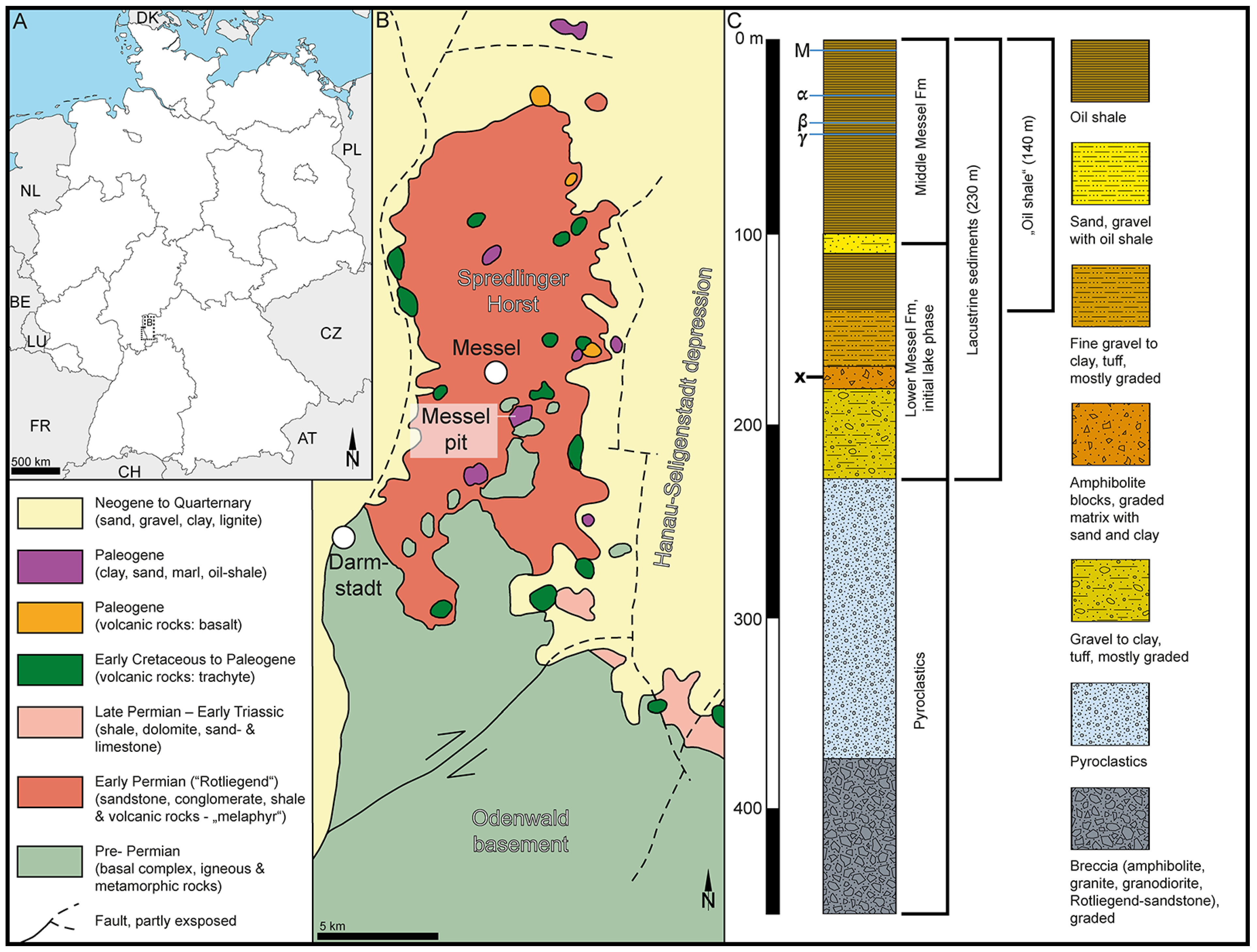

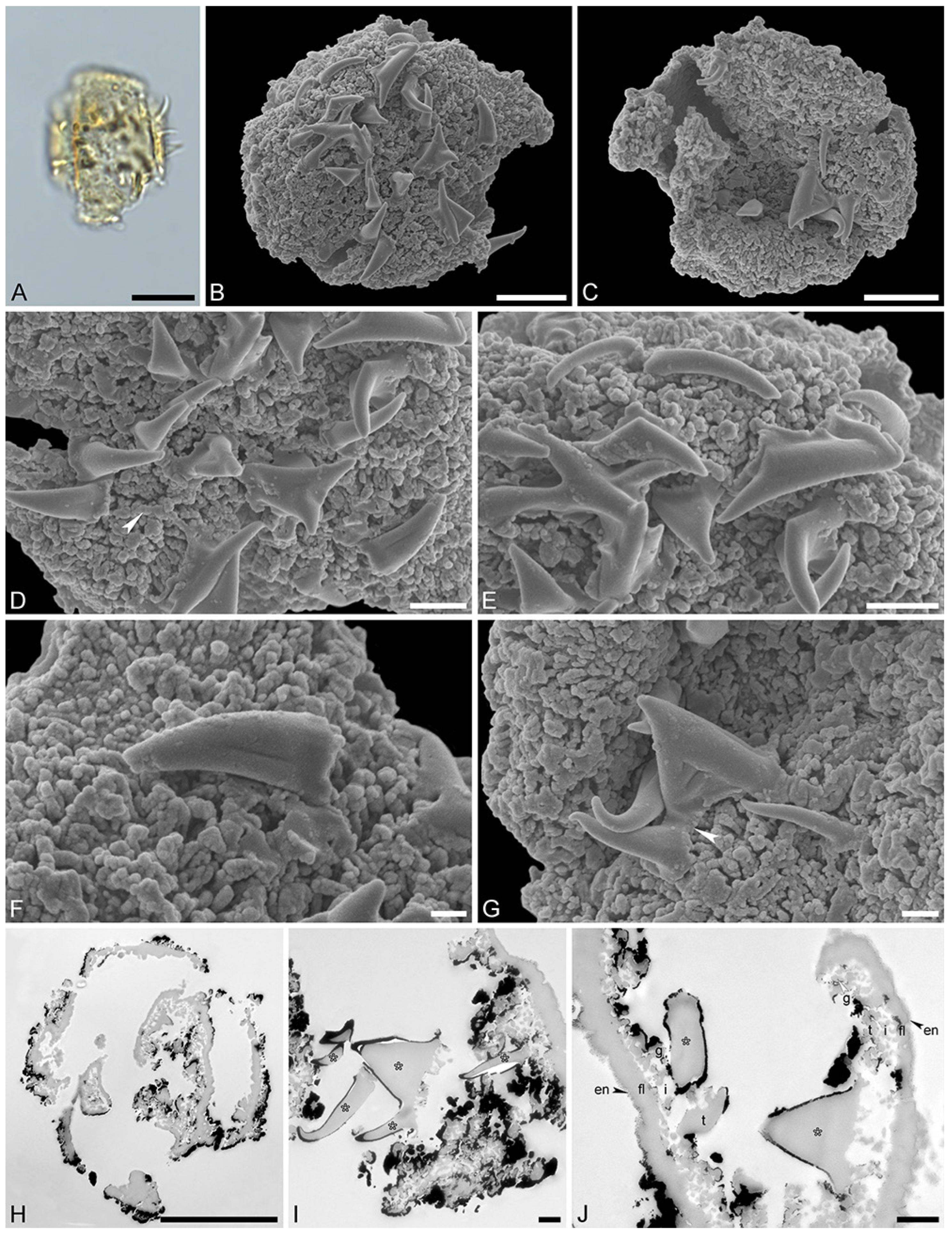

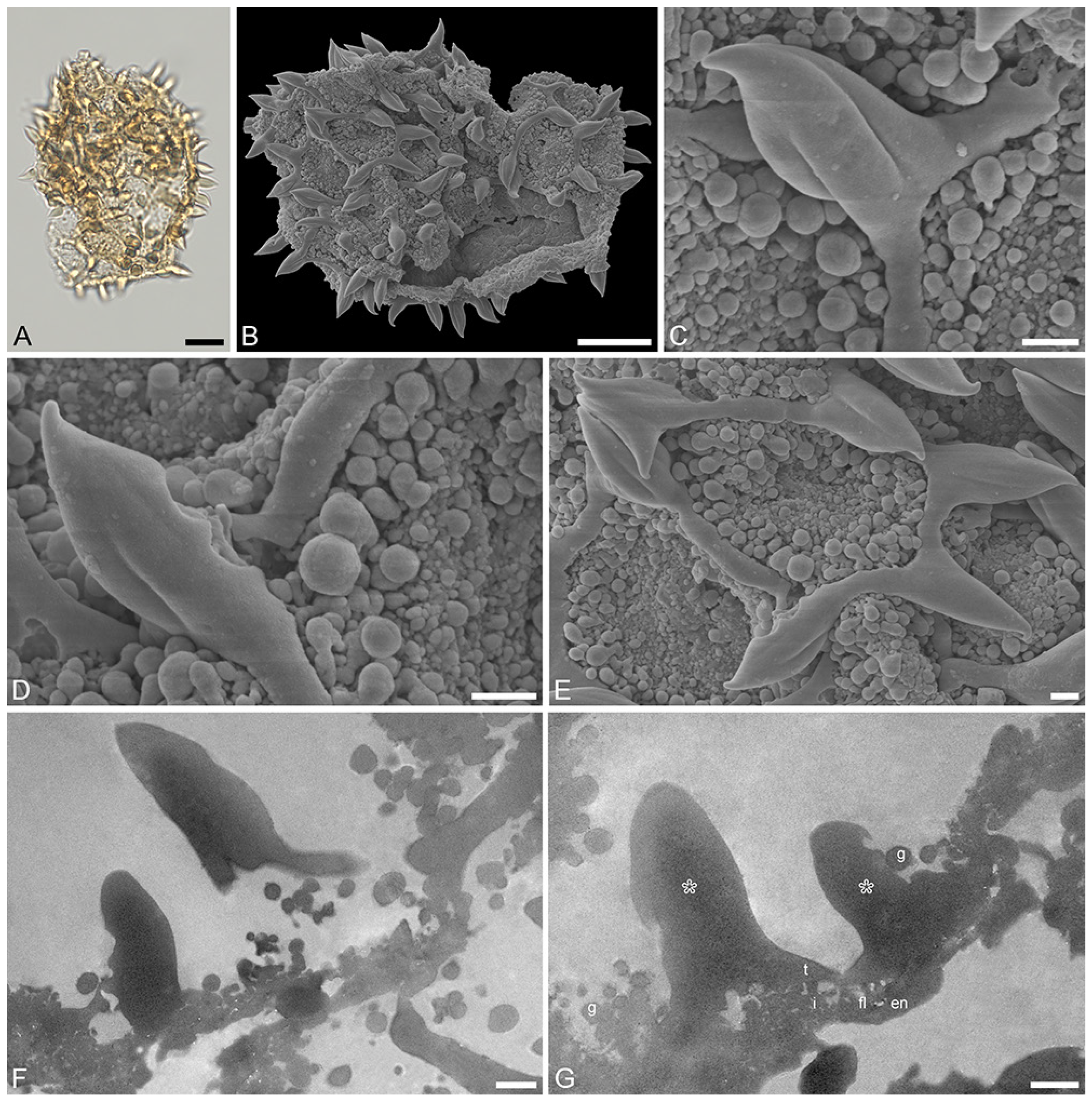
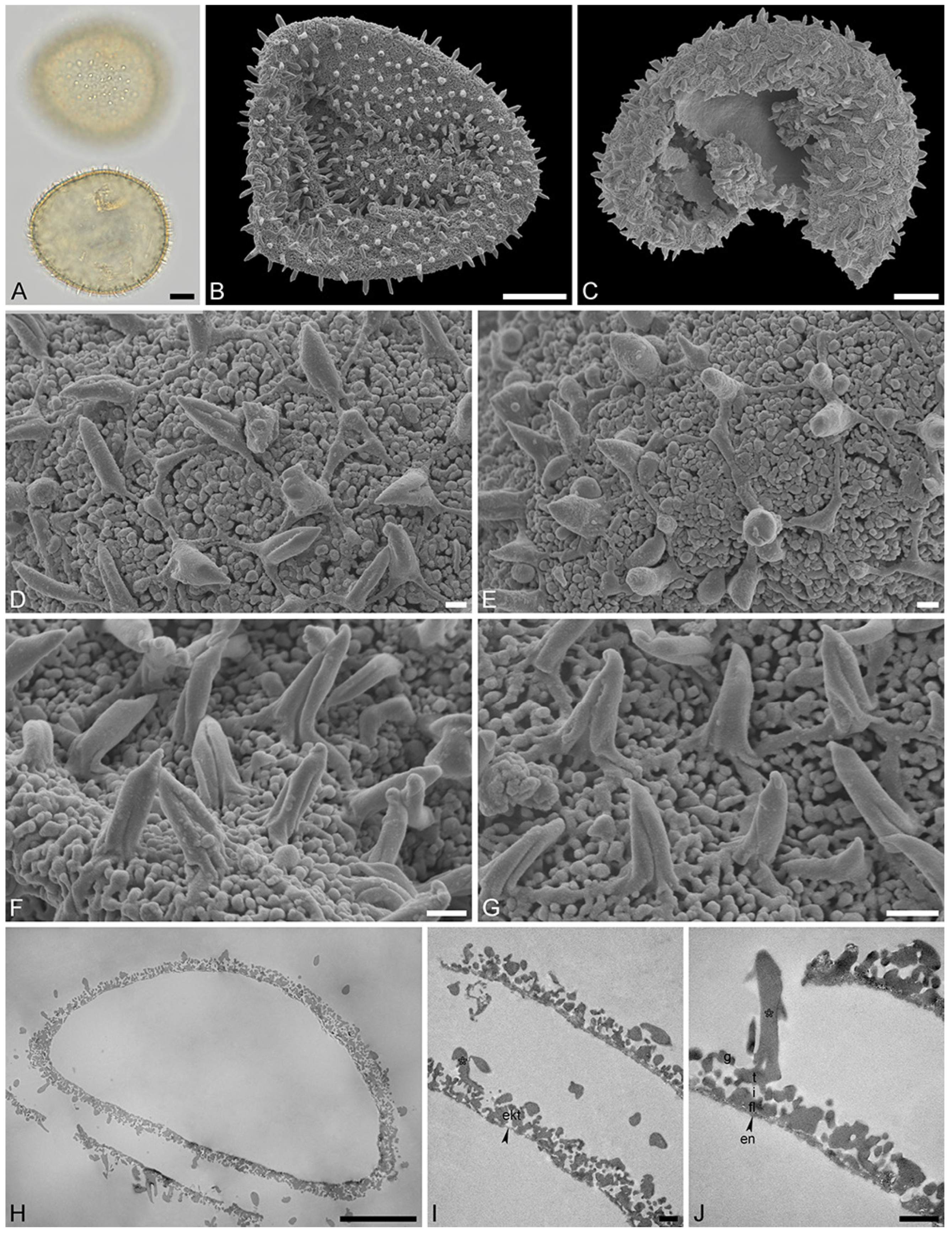
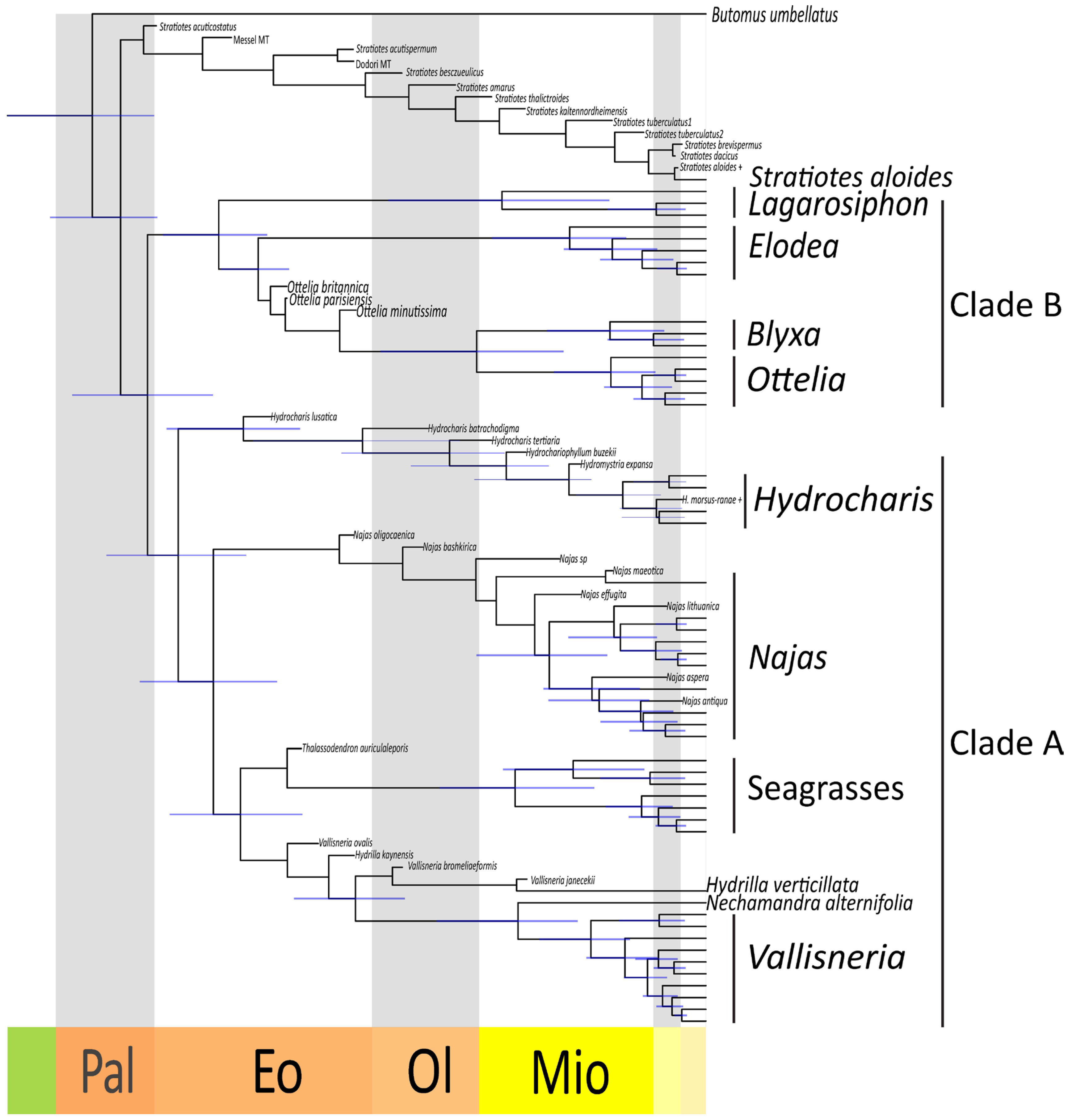
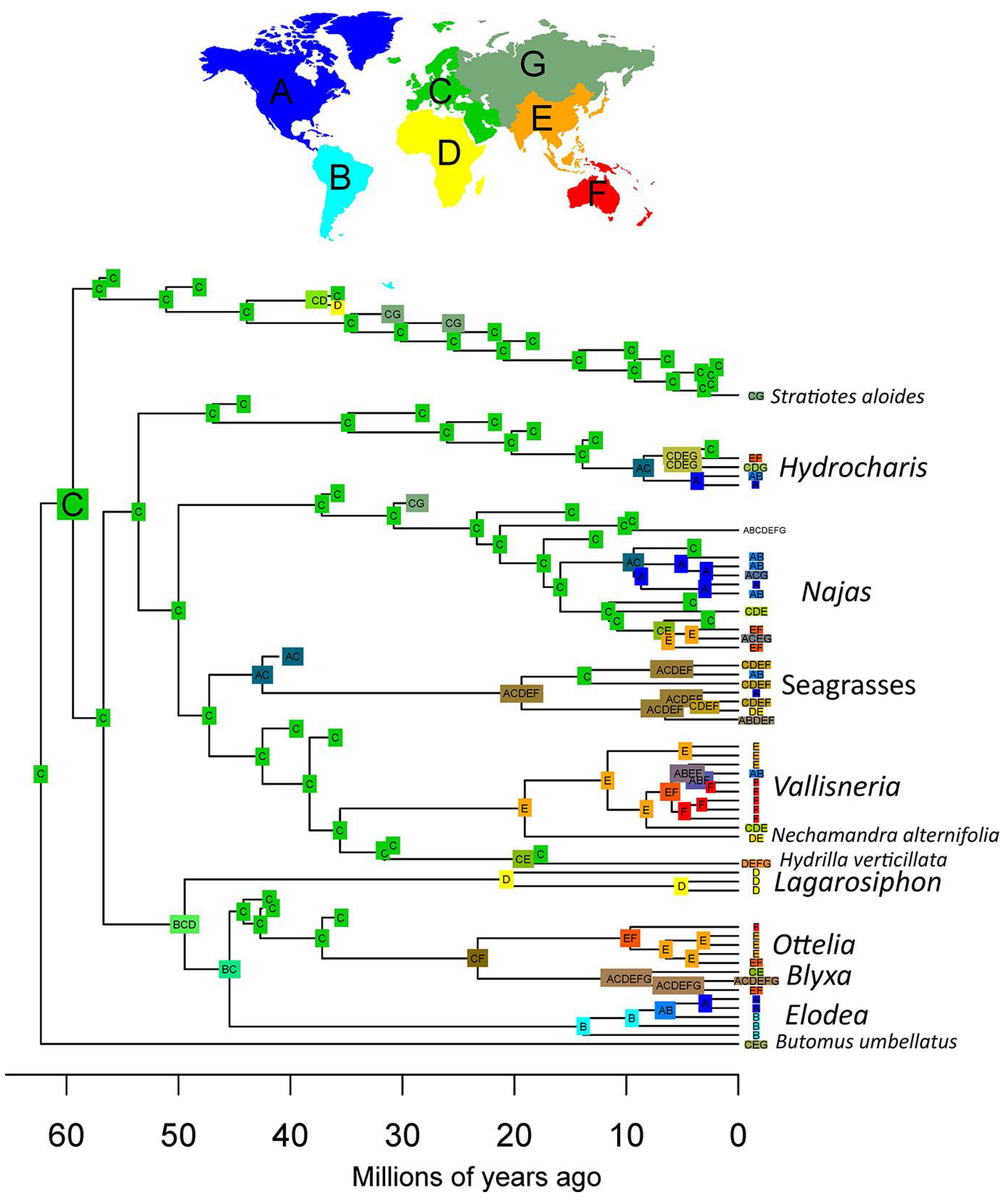

Disclaimer/Publisher’s Note: The statements, opinions and data contained in all publications are solely those of the individual author(s) and contributor(s) and not of MDPI and/or the editor(s). MDPI and/or the editor(s) disclaim responsibility for any injury to people or property resulting from any ideas, methods, instructions or products referred to in the content. |
© 2024 by the authors. Licensee MDPI, Basel, Switzerland. This article is an open access article distributed under the terms and conditions of the Creative Commons Attribution (CC BY) license (https://creativecommons.org/licenses/by/4.0/).
Share and Cite
Ulrich, S.; Vieira, M.; Coiro, M.; Bouchal, J.M.; Geier, C.; Jacobs, B.F.; Currano, E.D.; Lenz, O.K.; Wilde, V.; Zetter, R.; et al. Origin and Early Evolution of Hydrocharitaceae and the Ancestral Role of Stratiotes. Plants 2024, 13, 1008. https://doi.org/10.3390/plants13071008
Ulrich S, Vieira M, Coiro M, Bouchal JM, Geier C, Jacobs BF, Currano ED, Lenz OK, Wilde V, Zetter R, et al. Origin and Early Evolution of Hydrocharitaceae and the Ancestral Role of Stratiotes. Plants. 2024; 13(7):1008. https://doi.org/10.3390/plants13071008
Chicago/Turabian StyleUlrich, Silvia, Manuel Vieira, Mario Coiro, Johannes M. Bouchal, Christian Geier, Bonnie F. Jacobs, Ellen D. Currano, Olaf K. Lenz, Volker Wilde, Reinhard Zetter, and et al. 2024. "Origin and Early Evolution of Hydrocharitaceae and the Ancestral Role of Stratiotes" Plants 13, no. 7: 1008. https://doi.org/10.3390/plants13071008





